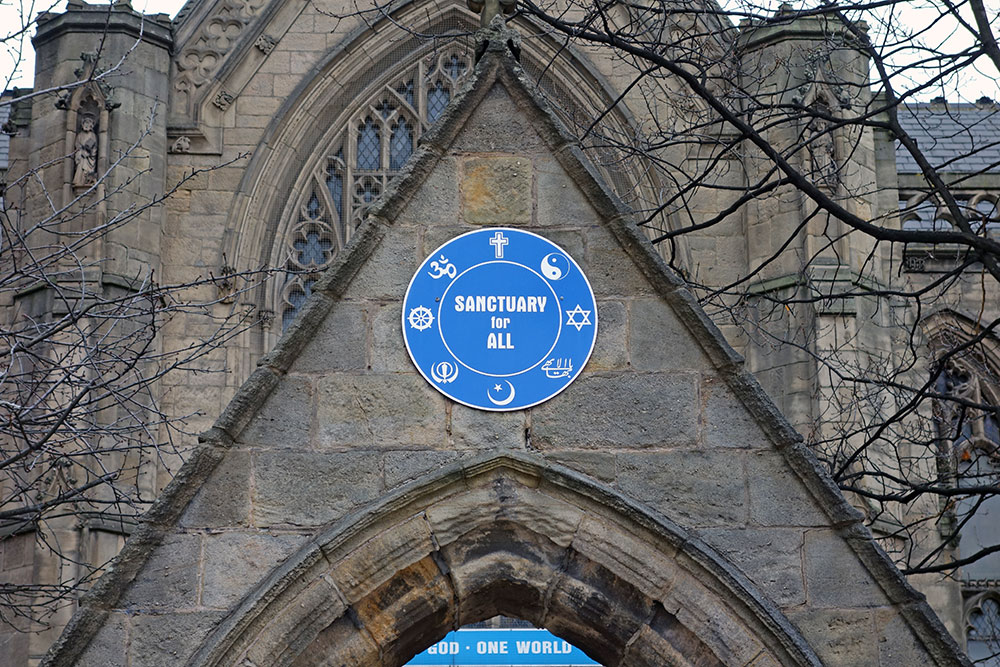Sri Chinmoy teaches that all religions and spiritual paths can lead to the same goal. Although they may differ in outer forms, they share the same underlying essence.
“Each individual seeker views the Creator and the creation according to his own aspiration and level of development. What we need is light to illumine our inner and outer differences. It is through our oneness-life that we will walk, march and run to the Supreme. We must have appreciation for and sympathetic oneness with all religions in order to create a harmony that will spread throughout the length and breadth of the world.â€
– Sri Chinmoy [1]
Religious tolerance and religious oneness
Tolerance for other religious paths is a good starting point. But, from a spiritual point of view, tolerance is only a first step, because grudging tolerance may still leave a sense of superiority. If a seeker feels his religion is superior to others, there is a sense of pride and separation. The best attitude is to feel that if the source of religious traditions is the same, there is no superiority and question of judgement. Let each go in his own way.
Outer imperfection and the inner reality
When we look at religions (or really any organisation on earth) there is imperfection. People who follow religions may fail to uphold the highest ideals of their religion, and even use religious affiliation as an excuse to justify their wrong behaviour.
But, at the same time we should try and understand the underlying essence of religion and spiritual paths.
“True religion has a universal quality. It does not find fault with other religions. False religions will find fault with other religions; they will say that theirs is the only valid religion and their prophet is the only saviour. But a true religion will feel that all the prophets are saviours of mankind. Forgiveness, compassion, tolerance, brotherhood and the feeling of oneness are the signs of a true religion.â€
– Sri Chinmoy, [2]
We cannot judge the inner spiritual reality of religious ideals by what adherents may or may not practise. The essence of religion is love of God, love of Truth and treating others as we would wish to be treated. To really experience the meaning of religion, we need to go beyond words and thought and experience the consciousness of the Higher Reality. This is not the realm of philosophy and words, but mysticism.
Sri Ramakrishna
Sri Ramakrishna was an uneducated spiritual Master from Bengal. From an early age he had a burning aspiration to realise God, to realise the Highest. The unique contribution of Sri Ramakrishna was to practise the religious and spiritual practices of all the major religions and spiritual paths. Sri Ramakrishna did not read books or give lectures on religion, he practised it in the purest sense. He was a mystic who devoted all his energy and aspiration towards God. After realising God, through devotion to Mother Kali (Hinduism), he also practised the Sadhana of Christianity, Buddhism, Islam and different Hindu sects – from Vedanta to Vaishnavism.
Sri Ramakrishna was able to experience the underlying spiritual essence of different religious paths. This was not a philosophical understanding, but his direct personal experience.
Swami Vivekananda and the Parliament of World Religions.
Swami Vivekananda was a close disciple of Sri Ramakrishna. In 1893, this young penniless monk travelled to America to participate in the inaugural Parliament of Religions.
“I am proud to belong to a religion which has taught the world both tolerance and universal acceptance. We believe not only in universal toleration, but we accept all religions as true.â€
– Swami Vivekananda 11th September, 1893, World Parliament of Religions
Vivekananda captured the imagination of America and the whole world by declaring the universal oneness of different religions. Vivekananda touched the intuitive feeling that as there are many people, so there are many paths. Vivekananda offered a clarion call for religious tolerance, and a brotherly feeling amongst the people of the world.
It was fitting that the spiritual successor of Sri Ramakrishna could give voice to the inner reality of what his Master had experienced. The 1893 World Parliament of Religions is widely considered to be the birth of the modern interfaith movement. In the Nineteenth Century the idea that different religions and spiritual paths had equal validity was very rare in the Western world. Now, it is more common, and hopefully this is the future – people learning to see different approaches to life as valid and losing a sense of superiority / inferiority.
Whether we follow a religion or no particular religion, the most important thing is the life we lead and how we treat others. If we can pray and meditate and have a good feeling towards the world, then we will be secure in with our own faith.
Related articles
- Friends with people from other religious / political divides – Nirbhasa
- Reason, experience and faith. – Tejvan
External links
- Personal experiences of interfaith – by Tejvan
Photo top: Mill Hill Unitarian Chapel, Leeds
References
[1] World-Destruction: Never, Impossible! Part 1, Agni Press, 1994
[2] World-Destruction: Never, Impossible! Part 1, Agni Press, 1994
